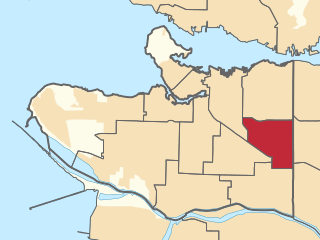Related Research Articles

An electoral district in Canada is a geographical constituency upon which Canada's representative democracy is based. It is officially known in Canadian French as a circonscription but frequently called a comté (county). In Canadian English it is also colloquially and more commonly known as a riding or constituency.

Peace River North is a provincial electoral district for the Legislative Assembly of British Columbia, Canada. It was created under the name North Peace River by the Constitution Amendment Act, 1955, which split the old riding of Peace River into northern and southern portions for the 1956 BC election. Its current name has been in use since 1991.
Surrey-Panorama Ridge was a provincial electoral district for the Legislative Assembly of British Columbia, Canada from 2001 to 2009. The district was created in the 1999 redistribution from the southern half of Surrey-Newton, and the western portion of Surrey-Cloverdale. It was abolished following the 2008 redistribution, with a large portion going to the new Surrey-Panorama riding.

Surrey-Whalley is a former provincial electoral district for the Legislative Assembly of British Columbia, Canada in use from 1991 to 2024.

Richmond Centre is a provincial electoral district for the Legislative Assembly of British Columbia, Canada. Located in the central portion of the city of Richmond, the riding was created in 1988, and elected its first member of the Legislative Assembly (MLA) at the 1991 provincial election. It was split into Richmond North Centre and Richmond South Centre following the 2015 British Columbia electoral redistribution.

Richmond-Steveston is a provincial electoral district for the Legislative Assembly of British Columbia, Canada.

Vancouver-Renfrew is a provincial electoral district of the Legislative Assembly of British Columbia in Canada.

Vancouver-Strathcona is a provincial electoral district for the Legislative Assembly of British Columbia, Canada.

Vancouver-Point Grey is a provincial electoral district for the Legislative Assembly of British Columbia, Canada. It was first contested in the general election of 1933. It was created out of parts of Richmond-Point Grey, South Vancouver and Vancouver City. The riding began as a three-member seat, and was reduced to a two-member seat in 1966 when Vancouver-Little Mountain was created. In the redistribution preceding the 1991 election, it was reduced to a one-member riding along with the other older urban ridings, as several new one-member ridings were created.
BC-STV is the proposed voting system recommended by the Citizens' Assembly on Electoral Reform in October 2004 for use in British Columbia, and belongs to the single transferable vote family of voting systems. BC-STV was supported by a majority of the voters in a referendum held in 2005 but the government had legislated that it would not be bound by any vote lower than 60 percent in favour. Because of the strong majority support for BC-STV, the government elected to stage a second referendum in 2009, but with increased public funding for information campaigns to better inform the electorate about the differences between the existing and proposed systems. The leadership of both the "yes" side and the "no" side were assigned by the government. The proposal was rejected with 60.9 percent voting against, vs. 39.1 percent in favour, in the 2009 vote.

Dunvegan-Central Peace was a provincial electoral district in Alberta, Canada mandated to return a single member to the Legislative Assembly of Alberta using the first-past-the-post method of voting from 2004 to 2012.

Following the 2005 electoral reform referendum, British Columbia held a second referendum on electoral reform in conjunction with the provincial election on May 12, 2009. As in 2005, voters in 2009 were asked were asked which electoral system should be used to elect legislators: the existing first-past-the-post electoral system or the BC single transferable vote electoral system (BC-STV) proposed by the British Columbia Citizen's Assembly on Electoral Reform to ensure more proportional representation in the provincial Legislative Assembly.

Surrey-Fleetwood is a provincial electoral district in British Columbia, Canada, established by the Electoral Districts Act, 2008. It was first contested in the 2009 election. Surrey-Fleetwood is an amalgamation of most of Surrey-Tynehead along with portions of Surrey-Green Timbers, Surrey-Newton and Surrey-Cloverdale.

Abbotsford West is a provincial electoral district in the Canadian province of British Columbia established by the Electoral Districts Act, 2008. It was first contested in the 2009 British Columbia general election.

Abbotsford-Mission is a provincial electoral district in British Columbia, Canada established by the Electoral Districts Act, 2008. It came into effect upon the dissolution of the 38th BC Parliament in April 2009, and was first contested in the ensuing election.

Bulkley Valley-Stikine is a provincial electoral district in British Columbia, Canada.
The federal electoral redistribution of 2012 was a redistribution of electoral districts ("ridings") in Canada following the results of the 2011 Canadian census. As a result of amendments to the Constitution Act, 1867, the number of seats in the House of Commons of Canada increased from 308 to 338. The previous electoral redistribution was in 2003.

The 2017 British Columbia general election was held on May 9, 2017, to elect 87 members (MLAs) to the Legislative Assembly to serve in the 41st Parliament of the Canadian province of British Columbia. In the 40th Parliament prior to this general election, the British Columbia Liberal Party formed the government under the leadership of Christy Clark, while the British Columbia New Democratic Party (NDP), under the leadership of Adrian Dix and then John Horgan, formed the Official Opposition; the Green Party of British Columbia were also represented in the legislature with sole MLA and later leader Andrew Weaver.

The 42nd Parliament of British Columbia was chosen in the 2020 British Columbia general election. All 87 seats were up for election.
References
- 1 2 "Electoral Boundaries Commission Reports". elections.bc.ca. Elections BC . Retrieved August 24, 2018.
- ↑ Electoral Boundaries Commission Act, RSBC 1996 c. 107, available online at
- ↑ "Electoral Boundaries Commission seeks 6 new B.C. ridings, revisions to 72 others". CBC. April 4, 2023.